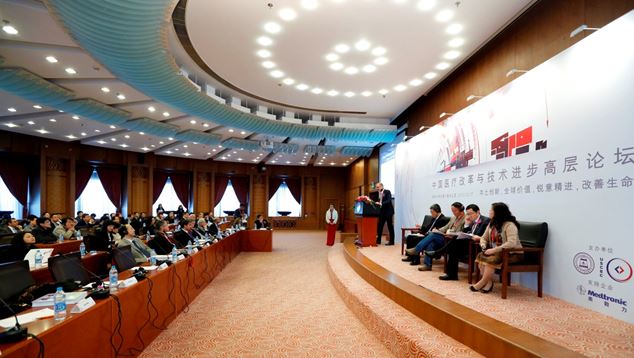Tsinghua University and the US-China Business Council co-hosted a symposium on China’s healthcare reform and the development of China’s medical technology industry
BEIJING – Dec. 18, 2013 – The Institute of Public Policy in the School of Public Policy and Management at Tsinghua University, in cooperation with the US-China Business Council, yesterday held a symposium aimed at exploring the role of medical technology innovation in improving healthcare systems and the environment needed for cultivating innovation in China’s medical technology industry. The symposium assembled a group of domestic and international healthcare experts, policy makers and business leaders; including distinguished speakers from the Chinese Food and Drug Administration, the Chinese Ministry of Science and Technology, the State Council Development and Research Center, the United Kingdom Department of Health, Stanford University, leading Class Three hospitals in Beijing, and others.

The symposium was held at a decisive time for the development of China’s healthcare system. From 2009 to 2011, the first stage of China's healthcare reform, the emphasis has been on the establishment of a basic medical care insurance system, implementation of the basic drug system and improvement of grass-roots medical services. These reforms have delivered significant results. Basic medical insurance coverage has soared from 5 percent in 2003 to 95 percent of the Chinese population in 2011. The Chinese people are benefiting from improved healthcare services, a longer lifespan, and a decreased infant mortality rate. Making healthcare reform one of the top priorities in the 12th Five Year Plan, the Chinese government has now embarked on more efforts to ensure improvements in the efficiency and quality of healthcare, with public spending on healthcare anticipated to increase from 5.2 percent of GDP in 2011 to 6.5-7 percent in 2020.
Professor YU Qiao
To open the symposium, Professor Yu Qiao from Tsinghua University’s School of Public Policy and Management addressed the positive relationship between technological innovation and healthcare reform. “China’s healthcare reform has entered a new chapter. Increased funding will definitely yield faster growth of the healthcare sector. Yet, how to improve quality and efficiency is vital for the sustainability of the newly established healthcare network. In this regard, innovations in medical technology play a critical role in making the best use of resources and reinforce the sustainable development of China’s healthcare system.”
Following Professor Yu’s remarks, discussions on how technological innovation advances healthcare systems were opened under the two themes “Innovation as the path to clinical and economic value” and “Fostering the development of an innovative medical technology industry”. Under these two themes, strategies to support and harness innovation to drive improved healthcare outcomes, as well as methods for different stakeholders to assess the value of medical technology innovation, were reviewed.
“Innovation in healthcare technology is a win-win for patients, hospitals, industry and the Chinese government as it advances reform. Better efficiency, quality, and value can be achieved through the creation and introduction of new technologies,” said Roberta Lipson, Board Member of US China Business Council. “The healthcare system involves many different contributors, each with diverse resources and a critical role. “ Ms. Lipson continued. “Healthcare policies should consider the different ways in which innovative technology can benefit the whole healthcare system and create alignment among different actors for value-centric innovations.”
Taking the medical device industry as an example, innovation frequently starts with inspiration from a medical professional who sees an unmet clinical need and an idea for a solution. Often, the medical professional needs to collaborate with technology experts from universities or the private sector to design and develop the solution. Strategies that encourage collaboration among universities, medical professionals, and industry – such as clear and straightforward rules on the creation and transfer of intellectual property and programs that support a culture of collaboration – are helpful for building a better foundation for the advancement of the medical technology industry.
Many speakers agreed that innovative products, technologies and therapies are central to improving patient outcomes and extending high-quality care to meet the broad needs of the Chinese population, and that innovation enables China’s healthcare system to create and receive more value.
The symposium was made possible through the support of Medtronic, Inc., a global leader in medical technology products and services. Medtronic pledged to partner with government and other institutions to better enable the development of medical technology in China to serve the country’s healthcare reform.